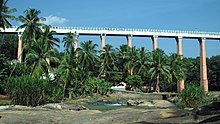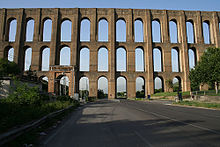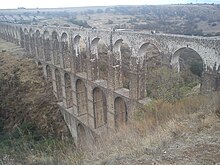Aqueduct (bridge)


Aqueductsare bridges constructed to conveywatercoursesacross gaps such as valleys or ravines. The termaqueductmay also be used to refer to theentire watercourse,as well as the bridge.[1]Largenavigable aqueductsare used as transport links forboatsor ships. Aqueducts must span a crossing at the same level as the watercourses on each end. The word is derived from theLatinaqua( "water" ) andducere( "to lead" ),[2]therefore meaning "to lead water". A modern version of anaqueductis apipeline bridge.They may take the form of tunnels, networks of surface channels and canals, covered clay pipes or monumental bridges.
Ancient bridges for water[edit]

Although particularly associated with theRomans,aqueducts were likely first used by theMinoansaround 2000 BCE. The Minoans had developed what was then an extremely advancedirrigation system,including several aqueducts.[3]
In the seventh century BCE, theAssyriansbuilt an 80 km long limestone aqueduct, which included a 10 m high section to cross a 300 m wide valley, to carry water to their capital city,Nineveh.[4]
Roman Empire[edit]
Bridges were a distinctive feature ofRoman aqueducts,which were built in all parts of theRoman Empire,from Germany to Africa, and especially in the city of Rome, where they supplied water to public baths and for drinking. Roman aqueducts set a standard of engineering that was not surpassed for more than a thousand years.[citation needed]
Modern aqueducts[edit]
[edit]
Navigable aqueducts, also called water bridges, are water-filled bridges to allow vessels on awaterwayto cross ravines or valleys. During theIndustrial Revolutionof the 18th century, navigable aqueducts were constructed as part of the boom in canal-building. A notable revolving aqueduct has been made on theBridgewater Canal.This allowed vessels to cross at high and low levels while conserving water that would be lost in the operation oflocks.
Notable aqueducts[edit]
Roman aqueducts[edit]


- ThePont du Gardin southern France
- Barbegal aqueduct,France
- Aqueduto de São Sebastião,inCoimbra,Portugal
- Eifel aqueduct,Germany
- Caesarea Maritima,Israel
- Patras,Greece
- Aqueduct of Segovia,Spain
- Acueducto de los Milagros,Mérida, Spain
- Tarragona,Spain
- Almuñécar,Spain (5 aqueducts – 4 still in use)
- Valens Aqueduct,Istanbul,Turkey
- Aqua Augusta,Italy
- Aqua Claudiaand theAnio Novus,as part of thePorta Maggiore,Rome, Italy
- Skopje Aqueduct,Skopje,North Macedonia
Other aqueducts[edit]
Europe[edit]
- France
- Aqueduct St-Clément,Montpellier,France – 17th century
- Roquefavour aqueduct,France – built between 1842 and 1847
- Greece

- Kavala aqueduct,16th-century Ottoman aqueduct in Kavala, Greece
- Malta
- Wignacourt Aqueduct,Malta;built in the 17th century to transport water fromDingliandRabatto the new capital cityValletta;today, most of its arches still survive in the localities ofAttard,Balzan,Birkirkara,Fleur-de-LysandSanta Venera
- Montenegro
- Bar Aqueduct,Montenegro– 16th century
- Portugal


- Aqueduto da Amoreira,inElvas,Portugal (built 1537–1620)
- Águas Livres Aqueduct,inLisbon,Portugal (built 1731–1748)
- Aqueduto de Óbidos,inÓbidos, Portugal(built 1570)
- Aqueduto de SetúbalinSetúbal,Portugal (built 1696)
- Aqueduto dos PegõesinTomar,Portugal (built 1593)
- Água de Prata Aqueduct,inÉvora,Portugal (built 1531–1537)
- Santa Clara Aqueduct,inVila do Conde,Portugal
- Russia
- Rostokino AqueductinMoscow(built 1780–1804)
- Spain
- Aqueduct of Teruel,Spain
Middle East[edit]
- Tabarjain Lebanon, aqueduct runs throughout the entire ancient town and is still actively used by the farmers of the area (built 1700–1750)
North America[edit]
- Greater Winnipeg Water District Aqueduct,Manitoba,Canada – built between 1915 and 1919
- High Bridge,part of the formerCroton Aqueduct,built in 1848, is the oldest surviving bridge in New York City
Latin America[edit]
- Carioca AqueductinRio de Janeiro,Brazil(built 1744–1750)
- Surviving Spanish aqueducts in Mexico:
- Aqueduct ofQuerétaro,Mexico – built between 1726 and 1738, 1.3 kilometres (0.81 mi) long and featuring 74 arches
- Aqueduct ofZacatecas,Zacatecas.
- Aqueduct of Padre Tembleque,Zempoala, HidalgoMexico – built between 1553 and 1570
- Aqueduct ofMorelia,Michoacán,built between 1735 and 1738
- Aqueduct of Los Remedios,Naucalpan, Mexico, 1765
- Aqueduct ofAcámbaro,Guanajuato,built in 1528[5]
- Chapultepec aqueduct,Mexico City
- Aqueduct of Guadalupe,Mexico City – present-day only partially preserved due Modern avenues works
- Aqueduct ofBogotá,Colombia,built in 1955, notable by being the most modern aqueduct of Latin America in the 20th century.
India[edit]

- Mathur AqueductinTamil Nadustate, India
Australia[edit]
- Boothtown AqueductinSydney,Australia(built 1886–1888)
Gallery[edit]
-
Aqueduct inSegovia,Spain
-
Pont du Gardnear the town ofVers-Pont-du-Gardin southern France
-
De los Remedios Aqueduct,Naucalpan,Mexico, Americas, modified due floodings
-
Traditional homes built between the arches of theÁgua de Prata AqueductinÉvora,Portugal
-
A small disused aqueduct inLeeds,England
-
Aqueduct inChihuahua.Mexico
-
19th century aqueduct inSydney,Australia
See also[edit]
- Ancient Roman architecture
- Ancient Roman engineering
- List of aqueducts
- List of canal aqueducts in the United Kingdom
- List of Roman aqueduct bridges
- Pipeline– some used to carry water
- Viaduct
- Water resources
Notes[edit]
- ^"aqueduct", Britannica CD 2000
- ^"aqueduct", Britannica CD 2000
- ^Minoan Aqueducts: A Pioneering Technology,ancient.eu
- ^Thorkild Jacobsen and Seton Lloyd, Sennacherib's Aqueduct at Jerwan, Oriental Institute Publication 24,University of Chicago Press,1935]
- ^Mexico – Travel
References[edit]
- Sextus Julius Frontinus,De Aquaeductu Urbis Romae(On the water management of the city of Rome), Translated by R. H. Rodgers, 2003,University of Vermont
- Chanson, H. (2002).Certains Aspects de la Conception hydrauliques des Aqueducs Romains. ('Some Aspect on the Hydraulic Design of Roman Aqueducts.')Journal La Houille Blanche, No. 6/7, pp. 43–57 (ISSN 0018-6368)
- Chanson, H. (2008)."The Hydraulics of Roman Aqueducts: What do we know? Why should we learn?"in Proceedings of World Environmental and Water Resources Congress 2008 Ahupua'a, ASCE-EWRI Education, Research and History Symposium, Hawaii, USA, Invited Keynote lecture, 13–16 May, R.W. Badcock Jr and R. Walton Eds., 16 pages (ISBN978-0-7844-0976-3)
External links[edit]
- Imperial Rome Water Systems
- 600 Roman aqueducts with 25 descriptions in detail
- worldhistory.org
- http://britannica.com/technology/aqueduct-engineering
- Chisholm, Hugh,ed. (1911)..Encyclopædia Britannica.Vol. 2 (11th ed.). Cambridge University Press. pp. 240–248.












